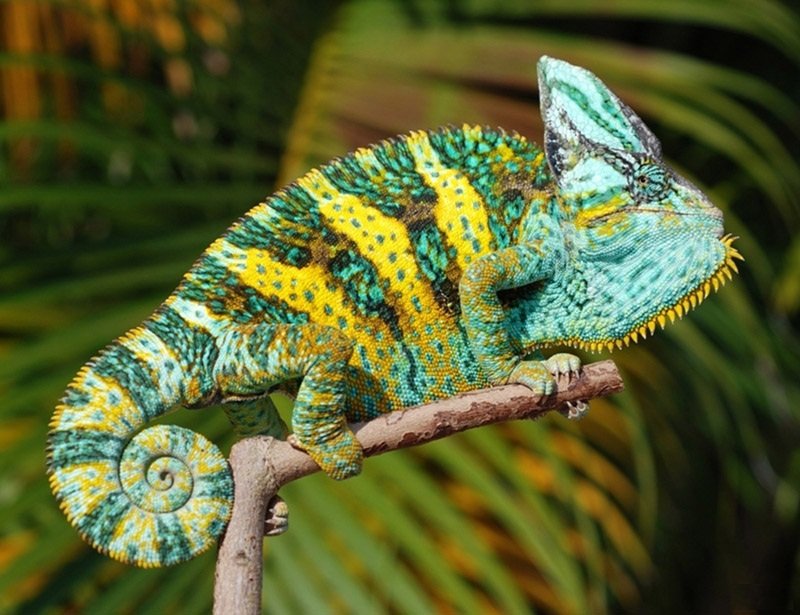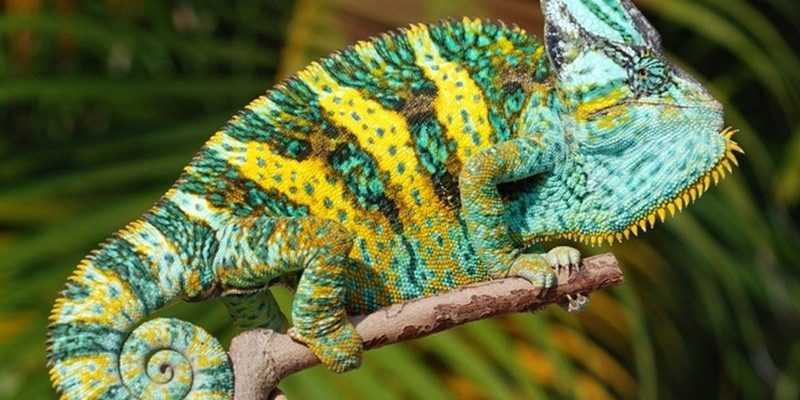
Let’s dive into the fascinating world of the veiled chameleon. These lizards are native to the dry, rocky deserts of Yemen and Saudi Arabia, which means they’ve had to get pretty creative to cope with their harsh surroundings. Everything from their skin to their eyes is designed to keep them alive and kicking in a tough environment. Grab a cup of coffee, and let’s explore how these colorful little survivors manage life in the wild.
Color Change: More Than Just a Fashion Statement
One of the most famous features of chameleons, including the veiled chameleon, is their ability to change colors. Honestly, it’s not just for show! This color change serves several important purposes. First off, it helps them blend in with their surroundings, making it harder for predators to spot them. Imagine being able to wear a camouflage outfit that adapts to your environment!
Beyond hiding from predators, color change is also a way for veiled chameleons to communicate. When they feel threatened, they can become darker and more vibrant as a warning to others. You might even notice them changing colors when they’re excited or looking for a mate. It’s fascinating how a simple shift in color can convey so many different messages!
Another factor in their color-changing ability is temperature regulation. This is especially crucial in the desert, where the sun can be scorching. By changing to lighter colors, they can reflect sunlight and cool down. Conversely, darker colors can help them absorb heat when it’s chilly. Talk about a versatile survival skill!
A Specialized Tongue for Catching Dinner
If you’ve ever watched a chameleon eat, it’s like witnessing magic. They have incredibly long, sticky tongues that can extend up to twice the length of their bodies! This special adaptation makes catching prey a breeze. The veiled chameleon mainly feeds on insects, and with their lightning-fast tongue, they can snag a bug in the blink of an eye.
The mechanics behind this tongue are remarkable. When it shoots out, it generates a vacuum that helps grab prey. This ability is not just for efficiency but also a safety measure; fewer movements mean less chance of alerting potential predators. Just think about how often you have to sneak up on something delicious without being spotted!
Moreover, they have excellent vision that aids in hunting. Chameleons can move their eyes independently. This means they can track multiple targets at once, giving them a significant edge when it’s time to grab lunch. You might start to appreciate the whole hunting experience a bit more after seeing how these little guys work!
Unique Feet: The Perfect Grip
Veiled chameleons have some of the most specialized feet in the animal kingdom. Their toes are structured in a way that helps them grip branches and stay steady on uneven surfaces. Imagine climbing a tree using your toes like a monkey! This adaptation is vital for navigating through their natural habitat, where they often need to make quick adjustments to avoid falling.
Their feet are zygodactylous, meaning they have two toes pointing forward and two pointing backward. This unique arrangement allows for a powerful grip on branches, making them excellent climbers. This ability not only helps them escape predators but also lets them access food high in the trees.
In addition to aiding mobility, these specialized feet allow them to reach sunniest spots for basking. Chameleons need warmth to digest their food properly, so being able to move around efficiently is a huge advantage.
Eyes That See It All
Chameleons are known for their remarkable vision. Their eyes can rotate 180 degrees in different directions, giving them a panoramic view of their surroundings. This means they can spot predators or prey without moving their heads, which could attract unwanted attention. You might say they have built-in security cameras!
This superb eyesight allows them to detect movement from afar, a crucial survival tactic. If they see a potential threat, they can quickly change their colors or move away. And not just that—they can also distinguish between colors and patterns, helping them find suitable mates and recognize fellow chameleons.
Additionally, their eyes allow for depth perception, which is critical when judging distances. This ability is particularly useful during hunting, helping them strike accurately at prey. The combination of independent eye movement and keen vision makes these reptiles one of nature’s best-equipped survivors.
Body Structure: Designed for Survival
The overall body structure of the veiled chameleon is another factor that aids its survival. They have a compressed body shape, which minimizes their profile against predators. Think about it—when you’re trying to hide, the last thing you want is to stick out like a sore thumb!
Their skin is rough and layered in a way that helps retain moisture, a huge advantage in their arid habitat. Staying hydrated is key, and this adaptation helps them do just that. It’s almost like having a built-in water bottle that they can use as needed.
Furthermore, the coloration of their skin also helps them regulate temperature. Along with their remarkable ability to adapt to their environment, these features contribute to their resilience in harsh conditions. You could say they’re like little desert ninjas!
Behavioral Adaptations: It’s All in the Personality
Veiled chameleons exhibit a mix of behaviors that aid in their survival. For starters, they often choose high, leafy spots to live in—this provides safety from ground predators and access to a sunlit spot for basking. The higher up they are, the less likely they are to be eaten.
Moreover, they tend to be somewhat territorial. Male veiled chameleons will often defend their space aggressively, using bright colors and displays to ward off competitors. This behavior ensures they have access to prime feeding and breeding grounds, which is essential for their survival and reproduction.
Another interesting behavior is their basking habit. Like solar panels soaking up energy, they’ll often stretch out in the sun to warm up. This is crucial for their digestion and overall health. You might say they have their self-care routine down to an art!
The Importance of Adaptations for Survival
The adaptations that make the veiled chameleon a survivor are not just fascinating; they highlight the complex relationship between an organism and its environment. Each feature, from their color-changing skin to their specialized feet, plays a crucial role in helping them thrive in a challenging habitat.
The way they hunt, communicate, and defend themselves illustrates the intricate dance of survival in the wild. As we learn about these adaptations, it becomes clear how each one is a piece of a larger puzzle, fitting together perfectly for their survival.
In a world where habitats are changing due to climate change and human interference, understanding these adaptations can help us appreciate just how resilient life can be. So, the next time you see a chameleon, remember—it’s not just a colorful lizard; it’s a survivor, equipped with nature’s best tools!
In summary, the veiled chameleon’s unique adaptations are a testament to the wonders of evolution. Their ability to survive in a harsh environment showcases the beauty of nature’s design and reminds us that every creature plays a role in the ecosystem. Whether you’re a fan of lizards or just someone curious about nature, it’s clear that these little reptilian marvels have an incredible story to tell.

